Analyzing Intel Core M Performance: How 5Y10 can beat 5Y71 & the OEMs' Dilemma
by Brett Howse & Ian Cutress on April 8, 2015 8:00 AM ESTClosing Thoughts
There is a lot to say about Core M performance. We have tested three very different devices, all with Core M inside - each device tackles the design philosophy of Core M from different directions, and it comes across in the results based on where each device stands. We started this analysis to answer the question "how can 5Y10 beat 5Y71?', and the results answer that quite clearly.
Dell Venue 11 Pro 7000 (5Y71)
Starting with the Dell Venue 11 Pro 7000, this is an 11 inch tablet with passive cooling and a small chassis. The plastic exterior helps with skin temperature, but hinders the ability of the device to radiate the heat that it generates.
This chart shows where Intel believes Core M can be done in a passivly cooled device, and it assumes a metal chassis which the Venue 11 Pro 7000 lacks. Device thickness, material, and chassis size all play a big factor in how much heat can be dissipated. Under sustained use, the Venue 11 Pro can get warm to the touch, but as seen in the previous pages the actual SoC temperature can spike very rapidly. This compromises performance, although everything is relative. Compromised Core M CPU performance is still quite a bit more powerful than a Silvermont core in an Atom.
Lenovo Yoga 3 Pro (5Y71)
The Yoga 3 Pro on the other hand is a convertible tablet, and is the only Core M device in our test with active cooling. Lenovo has gone to great lengths to ensure that it does not get hot in the hand, since it most certainly can and will be used when held. It has the lowest SoC temperature of any of the devices by quite a bit, although it is of course helped by the inclusion of a fan. Lenovo has clearly set a target SoC temperature of 65°C as the maximum they are comfortable with in order to keep skin temperatures where they want them. It does not really hurt the device in all workloads, and as we have seen the Yoga 3 Pro can even outperform a Core i5-5200U in cherry-picked scenarios. On sustained maximum performance though, the lower SoC temperature means that the CPU and GPU must cut back sooner than the other devices, which limits performance.
ASUS Zenbook UX305 (5Y10)
The ASUS Zenbook UX305 is a completely different device. It is a laptop, so skin temperatures are not as big of a concern, and while it does get hot at around 48°C on long workloads, that heat is well away from where you would normally be touching the device. Also, being made out of aluminum is clearly a huge benefit for a passively cooled device such as this, as it allowed the ASUS to consistently outperform the other Core M devices despite it being the lowest boost frequencies in the test. The performance of the Zenbook was very consistent, even on extended workloads, and on the DOTA 2 test, the Zenbook even outperformed the Latitude, although that was less to do with thermals and more to do with the lack of memory bandwidth on the Dell laptop.
Core M
So with all of this data, what more do we know about Core M? Clearly, Intel’s goal with Core M is to provide excellent performance on short workloads. It has higher boost frequencies than the Core i5-5200U that was included in this test, and it has 4 MB of L3 cache as well compared to 3 MB of cache on the i5. On certain workloads, performance can even surpass the i5-5200U. Race to sleep is not a new idea, but that is what Core M is designed to do, and it does it well. Run on very little power, and then when tasked with work, get it done as quickly as possible and get back to the low power mode. This is not unique to Core M of course, as the Core i5 does the exact same thing, however the much more restrictive thermal envelope of just a 4.5 watt TDP means that sustained workloads just have to suffer compared to a device with a 15 watt TDP.
We did see that happen too. The Core M scored very well in the PCMark 8 benchmarks, which attempt to emulate real world use rather than just performing a single task until it is done. The burst nature of this allowed Core M to have enough time in between work to keep the temperatures in check. On sustained work, this was not always the case.
On the 5Y71 vs. 5Y10 front, we have some clear lines drawn:
| Intel Core M Performance | |||
| 5Y10 Result ASUS UX305 |
5Y71 Result Lenovo Yoga 3 Pro |
5Y71 Result Dell Venue 11 Pro 7000 |
|
| Cinebench R15 ST | 82.14 pts | 90.85 pts | 86.00 pts |
| Cinebench R15 MT | 210.66 pts | 196.00 pts | 175.00 pts |
| PCMark 8 - Home | 2655 pts | 2443 pts | 2606 pts |
| PCMark 8 - Creative | 3056 pts | 3110 pts | 3064 pts |
| TouchXPRT 2014 | 654 pts | 820 pts | 764 pts |
| 3DMark Sky Diver | 2773 pts | 1624 pts | 1820 pts |
| 3DMark Cloud Gate | 4251 pts | 3685 pts | 3753 pts |
| 3DMark Ice Storm | 47527 pts | 49619 pts | 44911 pts |
| DOTA 2 | 34.0 fps | 26.5 fps | 25.2 fps |
It also shows just how much the individual device plays in how much performance is available. The ASUS has by far the best cooling solution of the three Core M devices, which is helped of course by the form factor. Lenovo could not get away with a 50°C surface temperature on a device that can be used as a tablet. It just would not work. The form factor of the Yoga 3 Pro plays against it on sustained workloads. The Dell Venue 11 Pro allowed a much higher SoC temperature, but it would also spike there very quickly. What we would really love to see is the Core M-5Y71 processor inside of the Zenbook to see just how much the increased boost of the 5Y71 compromises the performance on longer duration workloads, if it does.
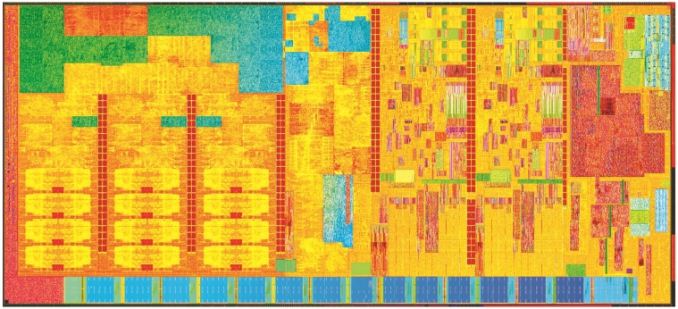
Die Shot of a Core M Processor
Is Core M a good processor? Or is it slow? It is clearly slower than a Core i5, but it would be hard to expect it not to be. On many daily workloads, it performs very well. On things like web browsing we are already to the point where the Yoga 3 Pro outscores a Core i7-860 4C/8T 95 watt desktop CPU from 2009 in web benchmarks. Since Core M is mainly aimed at thin and light devices, it can be expected that these are the kinds of workloads that one would perform on them. Many companies have jumped onboard with the smaller processor, as it allows a thinner and lighter device, and the possiblity of having no moving parts. Core M enables this with a much lower TDP than the next tier of mobile processors from Intel, as well as a smaller overall SoC which is thinner as well.
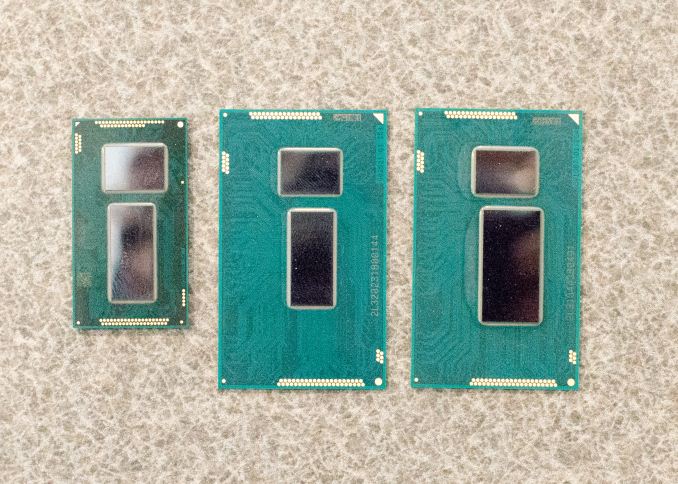 Broadwell-Y (left) vs Broadwell-U (center) vs Haswell-U (right)
Broadwell-Y (left) vs Broadwell-U (center) vs Haswell-U (right)
With the rise of tablets, the migration from hard desktops to smaller form factors has been unprecedented and Core M gives much more CPU performance than any tablet SoC available right now, at the expense of the additional cost the premium product brings. It is well suited to the types of workloads that many of us do during a typical day. There has been a lot of design wins already for this processor, covering a large range of device types and manufacturers. Even Apple has decided that there is a niche where a thinner and lighter version of their laptop may be of good use to their customers.
That said, there are a few other differences that set Core M apart from the mainline Core processors that need to be noted. For example, even though it shares the Gen8 Graphics with the Core i3 / i5 / i7 models in Broadwell-U, it is not quite as capable. It only has software HEVC decode for instance, which means that it might not be suitable for a Home Theatre PC without additional graphics helping out. Gaming is also a scenario where Core M can come up short, but only if you are comparing it to typical PC games. Tablet style games will have no issues, and Core M can perform similarily to other tablets in the GPU department.
In the end, we will quote one of Brett's favorite Formula 1 announcers and author, the great Steve Matchett. Everything is compromise. In Formula 1 racing, each corner of the track would need a different setup on the car for maximum results for that corner, and on the straights you would want most of the car’s downforce removed. Therefore every race and even every corner of a race is compromised for the maximum overall lap speed. The same can be said of Core M. In order to get something as powerful as the Core architecture inside of a fanless tablet, there is going to be compromise. In a Core M device, that is going to be sustained performance. What you give up in sustained performance though allows a thinner and lighter device, in form factors that would never have been possible with Core even one year ago. But it also means that the Core M SKU designation is only a sign of general performance, rather than absolute positioning. For that, we have to compare and contrast each unit in a review. Luckily, we hope to cover a large number of the important models over the next few months.



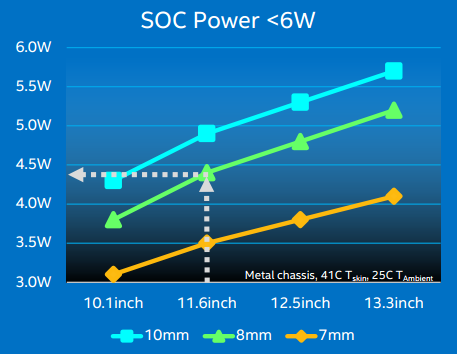
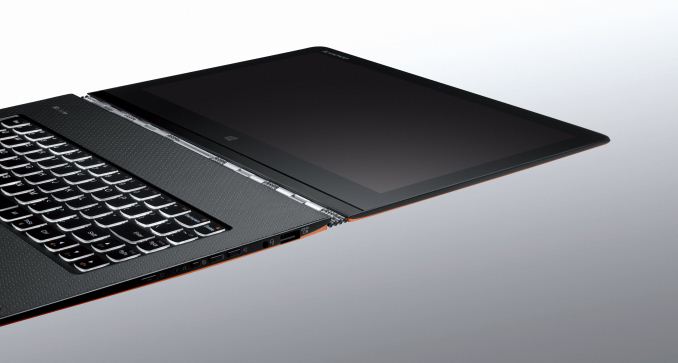
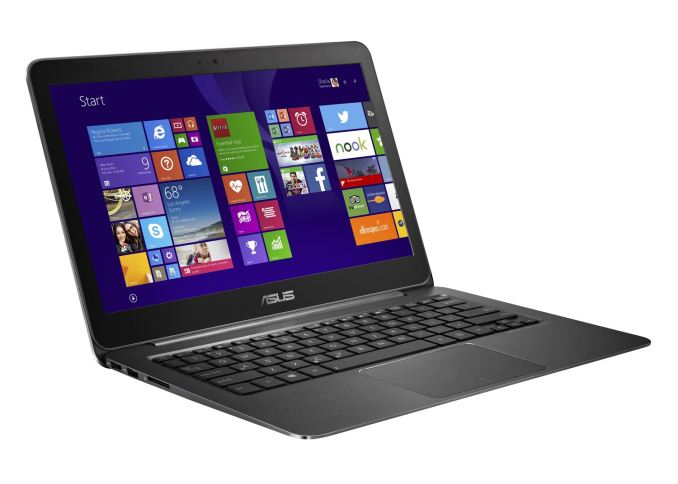








110 Comments
View All Comments
jabber - Thursday, April 9, 2015 - link
Be intrigued to know how these M chips stack up against my old CULV 1.3GHz SU7300. That benched as good as a old Pentium D 2.8Ghz back in 2009.Still using it as my main work laptop. Mainly just for configuring routers or downloading stuff on site.
fuzzymath10 - Thursday, April 9, 2015 - link
Probably not great. I'm using the Venue 11 Pro 7140, and the 5Y10 is usually snappier than my old 14" Dell Latitude with a T8300 (2.4GHz 45nm Core 2 Duo). Some of it might also be the awful GM965 IGP.fokka - Thursday, April 9, 2015 - link
thanks for the analysis, the new charts look very cool!it's interesting to see a direct comparison, how the different form factors and cooling solutions affect performance and it's good to have a "bog standard" 5200u thrown in for good measure, too.
i'm still not a fan of having low power systems burdened with high resolution screens, especially if it screws with graphics benchmark scores as we see on some benchmarks, but mabe that's just me.
it would be interesting to have the new macbook thrown in for comparison too, as far that is/will be possible. i'd expect it to perform closer to the asus, albeit with more throttling due to the smaller chassis and higher turbo clocks. but maybe we will se more soon.
the low temperatures on the lenovo are an interesting and valid design choice, but it would also be good to have an optional high performance mode allowing higher temps for when you simply sit at a desk playing games or such.
i also heard that there are ux305 variants coming out with different core-m SKUs, so it might even be possible to further investigate the boundaries of asus' cooling solution.
so all in all, while performance seems adequate for most day to day tasks, the only thing i'm still disappointed in regards to core m is efficiency/battery life. imho, this goes to show that core m is nothing else than a smaller, more constrained core i, with a lower TDP to allow for slimmer, fanless mobile designs.
for me that means i'm still preferring a "full blown" 15w ULV, simply to keep performance on a slightly higher, more consistent and more future proof level, even if it adds a couple millimeters to the thickness and a couple grams to the weight.
Qwertilot - Thursday, April 9, 2015 - link
The thing with battery life is that the U stuff has such low idle power states etc that there really isn't anything much to gain there. Especially as super thing means less battery.melgross - Thursday, April 9, 2015 - link
It has to be understood that these are essentially first generation products. Two years from now, they will make the ones tested today seem somewhat pokey. And two years after that...TheJian - Friday, April 10, 2015 - link
So based on the benchmarks of X1 here (58448 vs. Intel above 49619):http://www.anandtech.com/show/8811/nvidia-tegra-x1...
Intel's 14nm can't catch NV's 20nm X1 on the gpu side, and it's about to go 14nm samsung process in time for xmas devices (should up clocks on gpu, and denver back in perhaps tweaked for cpu side). This isn't good for Intel. I suspect they'll continue to lose 4.1B a year, or give up the portion of the market they bought with that 4.1B loss for the last few years each ;)
As gpu perf requirements amp up on mobile, I don't see Intel taking down ARM's side (qcom,samsung,nv, arm themselves etc). The cpu side will be good enough rev after rev on arm (A72's coming 1.9x A57's) and at some point have a full PC like box, massive PC style heatsink/fan, 16GB-32GB (google has to polish the 64bit OS more before there is a point to doing this), discrete gpu for top end, and pure amped up soc (with gpu, running ~20-80w or so like Intel's lineup) to cabbage up the low-end laptop/pc market. Intel profits will be going down soon if they don't buy NV to take out the fab/arm march that is coming up the chain slowly but surely. It would seem the only way to gun down arm at this point is to figure out a way to buy NV and produce a better ARM soc than anyone on arm's side can with the help of Intel's process (then their fabs would matter again, at least for a while if not forever far longer). Intel can't count on process to beat the enemy now. As they race to 10nm so is TSMC etc. Even if they always are one behind for a while as you can see above Intel isn't winning. Both i5's gpu and CoreM's gpu get smacked around even on 14nm vs. 20nm.
The core pro-app market is a different story, but that's the last part that gets assaulted at the top. Games first, then come the apps once a PC like box is out and has massive numbers to be worth making full pc apps, then pro apps over there etc. Google is surely working as fast as they can on the software side (64bit OS polish, more features etc probably coming Nov with devices), but it seems the hardware will already be ready for the next move to a PC type box when google+AEP etc/advanced unreal 4/unity5 etc games get there. We'll see how far NV gets with the 40w console shortly (the first small salvo I guess with semi-good gaming ability). They also have an updated handheld with X1 coming too, and I hope they update it again with 14nm at xmas or just after. I'll wait for 13in or larger 14nm NV chip for my tablet needs (training vids, and a side of games out to tv). I might buy the handheld x1 update though. I have zero interest in vita/3ds stuff.
One more point, if NV wins the suit against samsung, qcom etc, the rest will fold (or get sued too) and use NV IP which will make everyone have NV like scores on gpu. Again, Intel's best move is to buy NVDA. They'd be suing everyone then and could hold NV's IP back from all the rest or license it at higher fees etc, many ways to do damage owning NV. If win10 is really coming for ARM's side, and brings DX12 with it (kind of have to, to fight off Vulkan/android/iOS/linux/steamos jeez long list) then Intel is even in worse trouble. If they leave out DX 12 (really stupid with fully capable gpus over there, in NV's case maxwell!), I don't see the point for MS as they have to defend against android/vulkan and the rest of the gang I mentioned. MS must embrace ARM fully or Wintel is just headed down as the dominant player (OS share overall already dropping vs. arm's side totals). They'll both survive without the Wintel big stick to push around, but things are definitely changing quickly. Intel losing 4.1B just to sell something on mobile, doesn't lie. Mobile gaming is growing quickly, and it isn't running windows. etc...
serendip - Friday, April 10, 2015 - link
Much as I don't bother with ARM vs Intel debates, I agree with the main points here. Intel can't keep throwing away billions trying to catch up in mobile, especially when desktop and laptop sales are falling. People regularly buy new phones and tablets, PCs not so much. I find that for typical daily computing like web surfing, doing email and handling simple documents, any decent tablet or phablet will do. My laptop has been relegated to a desktop while my Android phablet and cheap Atom Windows tablet travel with me.ARM vs Intel now doesn't matter as much as before as long as good apps are available on whatever platform you choose. With the rise of cloud storage and services, your underlying OS and processor architecture matter even less. Not a good time for Intel after being in the lead for so long.
serendip - Friday, April 10, 2015 - link
That pro-app market will be Intel's last refuge, especially when x86 compatibility is needed. As for the rest, Atoms and ARM SOCs are getting good enough for general purpose computing. It'll be a race to the bottom then... I don't think Intel can maintain its current margins and structure in that environment.Brett Howse - Friday, April 10, 2015 - link
I don't mean to throw a wrench in your whole argument, but your initial numbers are incorrect. The X1 benchmark is showing the Ice Storm Unlimited *Graphics* score, and you are comparing it to the Intel *Overall* score. Easy mistake to make of course since you don't run these benchmarks all day like some.Anyway the Yoga 3 Pro (which you are quoting for Intel) achieved a 59405 Graphics score in that benchmark. The overall score combines the Graphics score with the Physics score (which was 31473 on the Yoga 3 Pro). I don't have the Tegra X1 Physics or Overall scores since that was a preview unit. The top ARM score on the Physics test was the NVIDIA Shield Tablet at 20437.
The NVIDIA tablet is also the highest scoring ARM on 3DMark Ice Storm Unlimited Overall with 36688.
But that's just one benchmark, and a very short one at that.
Xpl1c1t - Friday, April 10, 2015 - link
IC performance is a function of temperature?!?!?! Blasphemy!